|
From The Leviton Institute |
|||
| Reprinted from Leviton Institute |
Vol. 1 |
||
|
|
|||
|
|
|||
|
|
|||
| Leviton Institute Created to Educate Consumers on Electrical Safety and Products | |||
| The
Leviton Manufacturing Company, the nationís leading producer of home
electrical wiring devices, has formed the Leviton Institute to help
educate consumers about the latest wiring devices, and issues relating
to home electrical safety.
According to an Institute spokesperson, while the modern home is often brimming with state-of-the-art technology and equipment, the home-owner often overlooks the electrical wiring devices and cabling infrastructure required to support these new technologies. As a result, the Institute will provide homeowners with important information about the latest electronic wiring devices and technologies that can create an in-home network capable of supporting voice, video and data, as well as control networks for lighting, security, HVAC and home appliances. Initially, the Institute will focus its efforts on a variety of topics, including home automation, the home office, home retrofit, wiring, lighting controls, extension cords, home safety, and devices that meet the needs of the elderly or the physically impaired. The Leviton Institute will also address the needs of new home buyers who want to benefit from the conveniences and life-style enhancements associated with the pre-wired, fully automated home. Founded in 1906, when the use of electricity was still in its infancy, the Leviton Manufacturing Company is approaching a century of commitment to product excellence and customer service. The Leviton Institute is an extension of that legacy. The Leviton Institute is the educational arm of the Leviton Manufacturing Company. Its mission is to educate consumers, specifiers and others about the benefits of todayís electrical wiring devices and systems, and to promote the safe use of electrical devices in the home. |
|||
|
|
|||
| Lighting Tips for the Elderly | |||
To
help make your home safe for the elderly, the Leviton Institute offers
the following tips:
|
|||
|
|
|||
| New Lighting Controls Ease Safety Fears of Elderly | |||
 Finding
a light switch in a darkened room can be a major concern for the
elderly. And their concern is understandable. Recent studies show that
injuries from falls and other accidents are the sixth leading cause of
death among people 65 or older. Finding
a light switch in a darkened room can be a major concern for the
elderly. And their concern is understandable. Recent studies show that
injuries from falls and other accidents are the sixth leading cause of
death among people 65 or older.
Fortunately, the lighting control industry has developed a variety of new products that provide greater safety and added convenience for the elderly, and for others who want the benefits of the latest in lighting technology. According to the Leviton Institute, one such device is a motion-activated occupancy sensor, which eliminates the need to grope around in the dark for a light switch. When a person enters an unoccupied room, the sensor detects his or her presence and automatically turns on the light. In a similar fashion, when the room is unoccupied after a predetermined period of time, the light goes off automatically. Another type of lighting control that is gaining rapid popularity is the motion sensor that is designed for outdoor use. When a person walks into the sensorís coverage area Ė for example, up a driveway Ė the motion sensor automatically turns on the outdoor lighting to illuminate the area. As a result, these products serve as both safety and home security devices. Occupancy sensors and motion sensors offer users another important benefit: energy savings. "Because they automatically extinguish light when it isnít needed, these devices are very kind to oneís electric bill," says Dave Mastrone, a spokesperson with the Leviton Institute. "Thatís especially important for those who are on fixed incomes, but itís a great benefit for everyone who has them." One other type of lighting control that offers both convenience and safety is a hand-held remote Ė like the one for your TV Ė that turns lights on and off. The hand-held remote sends a signal to a wall-mounted receiver, which replaces the conventional "on" and "off" switch and fits in a standard wall box. Most of these new lighting controls devices are easy to install and can be purchased at home centers and hardware stores, although many homeowners prefer to hire a qualified electrical contractor to do the work. The Leviton Institute is the educational arm of the Leviton Manufacturing Company. Its mission is to educate consumers, specifiers and others about the benefits of todayís electrical wiring devices and systems, and to promote the safe use of electrical devices in the home. |
|||
|
|
|||
| How to Protect Your Child From Electrical Accidents | |||
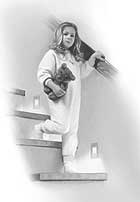 The
tendency of small children to stick their fingers in places where they
donít belong can sometimes create a problem for mom or dad. But the
result can be much more serious Ė in the form of a painful experience,
or even a fatality Ė when children poke around electrical outlets. The
tendency of small children to stick their fingers in places where they
donít belong can sometimes create a problem for mom or dad. But the
result can be much more serious Ė in the form of a painful experience,
or even a fatality Ė when children poke around electrical outlets.
To prevent your child from receiving an electrical shock, the Leviton Institute suggests that you cover exposed electrical outlets with protective devices. There are many types to choose from, including outlet caps that completely close off unused outlets, tamper-resistant outlets, and tamper-resistant wallplates and adaptors. The latter allow you to use an outlet, while preventing a child from poking fingers, pencils or other objects inside of it. "You canít be too careful when protecting small children from potentially harmful electrical devices and appliances," suggests Dave Mastrone, a spokesperson for the Leviton Institute. "Small children are naturally curious, and they simply donít understand the power of electricity." A favorite target of babies and toddlers are power cords, which they are apt to place in their mouth and chew. Consequently, parents should replace a worn or frayed electrical cord with one having an appropriate length. An even better idea is to keep young children away from cords altogether, since a child can actually choke on as little as 12 inches of cord. Children also love to tug on loose electrical cords. As a result, they can knock over a lamp, appliance or telephone, and injure themselves in the process. To prevent these types of accidents, the Leviton Institute suggests that all cords be placed out of the reach of small hands and that cord shorteners not be used to eliminate any loose wires. Here are additional safety tips to help protect your child from injury:
As the saying goes, an ounce of prevention is worth a pound of cure. Thatís especially true when it comes to home electricity. The Leviton Institute is the educational arm of the Leviton Manufacturing Company. Its mission is to educate consumers about the benefits of todayís electrical wiring devices and systems, and to promote the safe use of electrical products in the home. The Leviton Institute is the educational arm of the Leviton Manufacturing Company. Its mission is to educate consumers, specifiers and others about the benefits of todayís electrical wiring devices and systems, and to promote the safe use of electrical devices in the home. |
|||
|
|
|||
| Simple Steps to Make Your Home Electrically Safe | |||
| How
safe is your house from electrical shock and fire? Itís an important
question. Last year, some 700 people died in electrical accidents in the
U.S., and more than 40,000 homes were destroyed by electrical fires.
Sadly, many of these accidents and fires could have been prevented had the homeowners spent a few minutes to check the condition of their electrical products, and taken some simple precautions. |
|||
|
|||
|
To ensure that your home is electrically safe, the Leviton Institute suggests that you conduct an annual home safety audit. As part of the audit, you should examine the condition of your outlets, electric cords and extension cords, plugs, ground fault circuit interrupters, light bulbs, circuit breakers and fuses, exposed wiring, and entertainment and computer equipment. Water and electricity are a dangerous combination. In the bathroom, never let electric cords come in contact with water. Also, the Leviton Institute recommends that special receptacles, called ground fault circuit interrupters or GFCIs, be in-stalled wherever an electrical outlet is within six feet of water. The Leviton Institute is the educational arm of the Leviton Manufacturing Company. Its mission is to educate consumers, specifiers and others about the benefits of todayís electrical wiring devices and systems, and to promote the safe use of electrical devices in the home. The Leviton Institute is the educational arm of the Leviton Manufacturing Company. Its mission is to educate consumers, specifiers and others about the benefits of todayís electrical wiring devices and systems, and to promote the safe use of electrical devices in the home. Common electrical safety hazards to look for are:
|
|||
|
|
|||
| New Hot Tub or Spa May Require That You Have More Electrical Power | |||
| A hot
tub or spa may be just what the doctor ordered for relaxing tired
muscles, or soothing frayed nerves.
How can you tell if your homeís electrical service is adequate for a new hot tub or spa? A quick visual inspection of your electrical panel box should provide a clue. If your panel box has old-fashioned plug fuses that screw into the box, your electrical service is probably inadequate. This type of panel box generally supplies no more than 60 amps of electrical power, far below the recommended minimum of 100 amps. (A standard hot tub with just a few features requires at least 40 amps of electrical power.) Todayís electrical panel boxes use circuit breakers and provide at least 100-amp service. If you currently have 100-amp service, there must be at least two open slots in the panel box to accommodate an additional 40-amp breaker. Even with two available slots, the additional power required by a hot tub or spa might be more than your current electrical service can provide. If this is the case, it may be wise to upgrade to 200 amps when installing a hot tub or spa, advises the Leviton Institute. Consult with your electrical contractor to get sound advice on how much electrical power you need to meet current and future needs. Another thing to consider when purchasing a new hot tub or spa is a Ground Fault Circuit Interrupter (GFCI), which provides protection against electrical shock. The National Electrical Code requires that a GFCI be installed wherever an electrical receptacle is near a water source, regardless of whether it is inside or outside the home. In addition, the Leviton Institute recommends that your contractor install a surge protector to safeguard your new investment from damaging power surges. Surge protectors divert surges of electric power caused by lightning, as well as temporary power spikes generated inside the home. By understanding your electrical requirements before you purchase a hot tub or spa, youíll be in a better position to understand the full scope of the job and properly plan for the project. The Leviton Institute is the educational arm of the Leviton Manufacturing Company. Its mission is to educate consumers, specifiers and others about the benefits of todayís electrical wiring devices and systems, and to promote the safe use of electrical devices in the home. |
|||
|
|
|||
| Protect Your Home Office from Temporary Power Surges | |||
| Temporary
power surges can wreak havoc on home office equipment, even if thereís
no thunder or lightning in the forecast. Thatís because 80 percent of
all temporary power surges are generated from within the home, according
to the Leviton Institute.
Whatever the source, temporary power spikes can damage sensitive microprocessors inside computers and peripheral office equipment. They can also cause computer programs to lock up and become corrupted. How can you protect your home office equipment from these damaging spikes? According to the Leviton Institute, one way is to install an inexpensive power-strip that incorporates a surge protection feature. Power strips with surge protection typically contain four to seven electrical outlets and are easy to operate. Simply plug your computers, peripherals and other equipment into the power strip, then plug the power strip into a conventional electrical outlet. With that, your protection is in place. Some of the newer power-strip surge protectors feature additional outlets for plugging in telephone jacks and cable TV connectors. Thatís because telephone and cable wiring can also carry damaging power surges to electronic equipment. High-end surge protection devices are also available with a diagnostic light that shows if the electrical wiring in the home has a grounding circuit. Some even have an alarm that sounds if the surge protector is damaged by an extreme power surge. Still other surge protectors come as wall receptacles. These devices replace standard electrical outlets, and help reduce the messy jumble of wires that results when too many plug-in devices are used in the home office. When shopping for a surge protector, the Leviton Institute advises that you look for a device that displays the current Underwriters Laboratories (UL) mark relating to transient voltage surge suppressors. This assures you that the product meets the manufacturerís safety standards, as well as all applicable electrical codes. A typical plug-strip surge protector retails between $10 and $40. However, you may want to increase your protection if you have a substantial investment in office equipment, or if you own other expensive electronic equipment, such as a large-screen TV or a state-of-the-art home entertainment center. To protect your entire house against temporary power surges, consider having a qualified electrical contractor install a meter socket surge arrestor at your electric meter, and indoor and outdoor panel-mounted devices next to the circuit breaker panel. Contact your local electrical utility for installation instructions for a meter socket surge arrester. These devices offer the ultimate in protection against all types of power surges in the home. |
|||
|
|
|||
| Ground Fault Circuit Interrupters Could Save Your Life | |||
| Mixing
water and electricity can be a shocking experience. In fact, each year
more than 300 people are electrocuted, and thousands more injured from
electrical shocks or electrical fires in and around the house.
According to the Leviton Institute, a leading authority on electrical safety, a GFCI is an electrical receptacle that has the ability to monitor the flow of electricity from the receptacle to any electrical device that is plugged into it. When a GFCI senses that the same amount of electric current is flowing out to the appliance and back to the GFCI outlet, all is well. However, when the GFCI detects that some of the current is not returning to the receptacle Ė and is, instead, "leaking" Ė it will quickly turn off the power to the outlet to prevent the possibility of electrocution. To take a real-world example, suppose you were in your backyard, standing by a wading pool while listening to a portable radio that was plugged into a regular receptacle. If someone accidentally knocks the radio off its stand and into the pool, a very dangerous electrical situation now exists. If you were to retrieve the radio, you could be electrocuted. However, if the radio were plugged into a GFCI receptacle, and you were to reach into the water to retrieve the radio while your foot was on the ground, the GFCI would detect a leak, shut off the power almost immediately, and prevent you from being shocked. "Ground Fault Circuit Interrupters are so effective and so inexpensive, that it is truly a shame they arenít in use in every home," says Dave Mastrone, spokesperson for the Leviton Institute. Many code organizations agree. The National Electric Code, for example, has required that all homes built since the mid-1970s have GFCIs in-stalled wherever an electrical receptacle is within six feet of a water source. Consequently, GFCIs are found in the bathrooms, kitchens, garages and unfinished basements of newer homes. GFCI receptacles are also required around pools, spas, hot tubs and similar outdoor installations. But many homes built before 1975 are not equipped with GFCIs. If your home is one of them, the Leviton Institute suggests that you call a licensed electrical contractor to install GFCI receptacles wherever they may be needed. |
|||
|
|
|||
| How you can test a GFCI | |||
| If your home is equipped with a Ground Fault Circuit Interrupter receptacle, the Leviton Institute advises that GFCIs be tested monthly to ensure they are functioning properly. To conduct the test, simply follow these steps: | |||
|
|||
|
|
|||
| How to Use Electrical Extension Cords Safely | |||
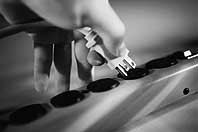 Extension
cords, with their ability to bring any appliance or lamp within easy
reach of an electrical outlet, are one of the most convenient products
in the home. But when they are misused, they can also be a source of
potential danger. Extension
cords, with their ability to bring any appliance or lamp within easy
reach of an electrical outlet, are one of the most convenient products
in the home. But when they are misused, they can also be a source of
potential danger.
The U.S. Consumer Product Safety Commission (CPSC) estimates that some 3,000 people are treated each year for injuries associated with extension cords. In addition, the CPSC reports that improperly functioning extension cords cause 5,000 residential fires annually. While extension cords are an invaluable convenience, itís important to use them properly. But what does that entail? Here are some tips from the Leviton Institute:
Following this advice will go a long way to ensure that your extension cords will always be used in a safe, efficient manner. |
|||
|
|
|||
| How to Choose The Right Extension Cord | |||
| Extension cords are generally rated in amps and volts, while light bulbs and appliances are measured in watts. To determine if an extension cord is properly rated for the number and types of devices being plugged in, add the total wattage of each bulb or ap-pliance and then divide by 120 to calculate the total number of amps. If the total amps is equal to or greater than the maximum rating of the cord, you must use a higher rated extension cord. | |||
|
|
|||
| How to Inspect Electrical Cords and Plugs | |||
 To
make your home as electrically safe as possible, the Leviton Institute
suggests that you take a few minutes each year to inspect the condition
of your electrical cords, extension cords, plugs and outlets. Hereís
what you should look for: To
make your home as electrically safe as possible, the Leviton Institute
suggests that you take a few minutes each year to inspect the condition
of your electrical cords, extension cords, plugs and outlets. Hereís
what you should look for:
First, keep your eyes open for any electrical cords that are worn or damaged. Statistics show that two-thirds of all electrical fires are caused by these items. Replace any electrical cords that are in poor condition. Next, check all electrical plugs to make sure they fit snugly into their outlets. Plugs that are loose or that wobble in the outlet are potential fire hazards, and should be repaired or replaced. Also make sure that you or another family member havenít forced any three-prong plugs into a two-slot outlet. Appliances with three-prong plugs should only be inserted into three-slot outlets or three-slot extension cords. Outlets, too, can pose a safety hazard if they are worn or damaged. Should you find any in this condition, the Leviton Institute recommends that a qualified person replace them as soon as possible. Also, check that all cords between power supply, extension cords and wall outlets are secure and that there are no exposed blades (prongs). Take a moment to gauge the temperature of the faceplates on your electrical outlets. If a plate is warm or hot to the touch, it could indicate a potentially serious wiring problem that should be further investigated by a qualified electrician. In addition, take note of any switchplates that are discolored. Discoloration could indicate that the electrical wiring behind the switchplate is overheating. Inspect all switchplates in the same manner, testing to see if they are warm. Finally, make sure that you have not overloaded any circuit or extension cord. Remember that extension cords are not intended to permanently extend a homeís wiring system. Between these annual inspections, experts at the Leviton Institute recommend that you be alert to the performance of your electrical system. Here are some telltale symptoms of home electrical wiring problems:
Before any work is done on your electrical system, always disconnect power from the circuit breaker panel or fuse box before attempting to replace a worn or damaged wall outlet (or call a qualified electrician to perform the work). |
|||
|
|
|||
| How to Silence Buzzing Light Bulbs | |||
 A
dimmer switch is the ideal way to control the lighting levels in each
room of your house, but in some circumstances, it can cause light bulbs
to produce an irritating, buzzing sound. If youíve ever experienced
this phenomenon and wondered how you can eliminate the buzz, here is
some advice. A
dimmer switch is the ideal way to control the lighting levels in each
room of your house, but in some circumstances, it can cause light bulbs
to produce an irritating, buzzing sound. If youíve ever experienced
this phenomenon and wondered how you can eliminate the buzz, here is
some advice.
According to the Leviton Institute, the source of the buzz can be either your light bulb or your dimmer. In either case, the problem is simple and inexpensive to correct. First, try replacing your existing light bulbs with higher quality bulbs from a different manufacturer. In many cases, this will resolve the problem. The reason this simple step can often stop the buzzing has to do with the quality of the two main components inside the bulb, the support posts, and the fine coils of wire, called the filament. When the bulb is turned on, the electric current running through the filament turns it into a magnet (just like the grade-school science experiment where a wire is wrapped around a nail and then connected to a battery, turning the nail into a magnet). A dimmer switch works by varying the amount of current going to the bulbís filament. When the dimmer is turned all the way up, the bulb gets full power. However, when the dimmer is turned down, less power goes to the bulb, and this causes the magnetic field in the filament to get stronger. As a result, the filament vibrates against the support posts. If the posts inside the bulb are flimsy, they may "buzz" from the vibration, but if they are sturdier, like those used in most high quality light bulbs, no vibrating sounds will be emitted. If, after changing the bulb, you still hear the buzz, consider upgrading your dimmer switch. Typically, dimmers in the mid-price range of $25 to $35 will not cause light bulbs to buzz because they do a better job of altering the current going to the light bulbs. |
|||
|
|
|||
| New Dimmer Switches Meet a Variety of Needs | |||
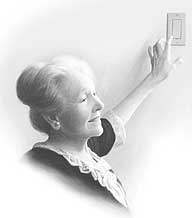 A
new generation of dimmers offering high-tech features and stylish looks
is giving consumers, accustomed to traditional, rotary-style dimmer
switches, some interesting new options, according to the Leviton
Institute. A
new generation of dimmers offering high-tech features and stylish looks
is giving consumers, accustomed to traditional, rotary-style dimmer
switches, some interesting new options, according to the Leviton
Institute.
Typical of these modern dimmers is one featuring a touch pad that responds to the placement of your finger. Simply put your finger anywhere on the touch pad, and the lights go on. Slide your finger up the touch pad, and the lights get brighter; slide your finder down the pad, and the lights get dimmer. |
|||
|
Another popular style of dimmer has a large rocker-style switch thatís easy to operate. A simple tap on the upper portion of the rocker switch brightens the light. A tap on the lower portion dims it. Dimmers are now available with a preset switch that remembers the last selected brightness level. Other modern dimmers use linear slide controls for easy and precise operation. And, of course, for those who prefer more traditional styling, the standard, inexpensive rotary switches are still available as well. Meanwhile, the most advanced dimmer switches offer scene lighting control capabilities. With scene lighting in a large living room, for example, the dimmer could be programmed to control a chandelier, track lighting and table lamps. At one setting, the table lamps could be set on full brightness, the track lights on medium, and the table lamps on low; at another setting, the track lights could be on full brightness, and the chandelier and table lamps on medium brightness. In similar fashion, all the lights could be set on full brightness, or on a low setting to add a soft glow to the room. Given all of these options, consumers are starting to use dimmers in more than just their dining rooms. Today, these devices are just as likely to be found in bedrooms, bathrooms, home offices and other parts of the house, according to the Leviton Institute. The reason is simple: dimmers can quickly change the type of light used from task lighting to accent lighting, or to general ambient light.
Likewise, in the bedroom, a dimmer enables you to switch instantly from task lighting for reading, to ambient light when watching TV. Even the workshop or garage can benefit from a new type of dimmer switch designed for use with fluorescent lights. These switches can control lighting for a single fluorescent lamp or an entire bank of lights. |
|||

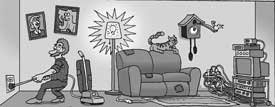
 Yet, both hot
tubs and spas require plenty of electricity to run their motors and
heaters. In fact, the extra load could be more than your current
electrical service can accommodate. Thatís why the Leviton Institute
suggests that you consult with an electrical contractor before
purchasing these appliances.
Yet, both hot
tubs and spas require plenty of electricity to run their motors and
heaters. In fact, the extra load could be more than your current
electrical service can accommodate. Thatís why the Leviton Institute
suggests that you consult with an electrical contractor before
purchasing these appliances. Some of
the common sources of these power surges include household appliances
such as air conditioners, washing machines, clothes dryers and
refrigerators. But the culprit could also be part of your home office
setup Ė a laser printer or photo copier, for example Ė or even
fluorescent lights.
Some of
the common sources of these power surges include household appliances
such as air conditioners, washing machines, clothes dryers and
refrigerators. But the culprit could also be part of your home office
setup Ė a laser printer or photo copier, for example Ė or even
fluorescent lights.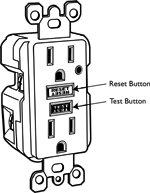 The
statistics are tragic. But what is even more tragic is that so many
electrical injuries could be avoided through use of a simple,
inexpensive device called a Ground Fault Circuit Interrupter (GFCI).
The
statistics are tragic. But what is even more tragic is that so many
electrical injuries could be avoided through use of a simple,
inexpensive device called a Ground Fault Circuit Interrupter (GFCI).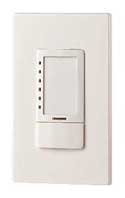 In the
bathroom, for example, a dimmer allows you to have task lighting when
shaving or putting on makeup, but softer, ambient light when getting a
glass of water in the middle of the night.
In the
bathroom, for example, a dimmer allows you to have task lighting when
shaving or putting on makeup, but softer, ambient light when getting a
glass of water in the middle of the night.